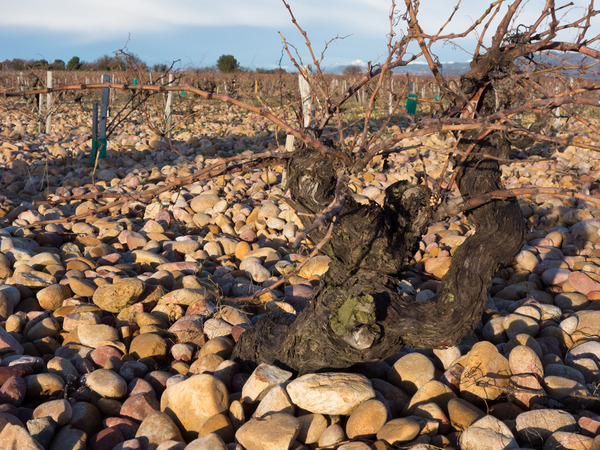To till or not to till?
The trend is towards less tillage, but could it be detrimental to vineyards?
The following is from an article originally published in Wine Business Monthly in June of 2019. Read the original here.
I recently attended a tour of some vineyards in central Spain. I had been to Spain a few times before this recent visit but was struck by the vineyards in the La Mancha region, which were rather extensive plantings of very low head-trained (a.k.a. bush) vines, widely-spaced and whose vineyard floor had been completely denuded of any other vegetation besides the vines themselves. This practice has been traditional in the region, which receives about 20 inches of rainfall annually and whose soils are very shallow and rocky. Because the soil overlies limestone, roots go down to only about 30 inches of depth or less.
Nevertheless, they do have irrigation available in the La Mancha region and some vineyards there are experimenting with cover crops in order to build their soils, which otherwise tend to look like barren wastelands. Here in California, it is becoming more and more uncommon to witness vineyard floors with such a “scorched earth” appearance. Growers have been employing cover crops, either by sowing a blend of grasses, legumes or insectary flowers, or by allowing the “native” vegetation to grow during the winter and managing it during the growing season. The current trend has been to reduce or eliminate tillage from the row middles (i.e. tractor row). But is leaving the cover crop in the tractor row a source of competition for the vines and could it be more detrimental than it is beneficial? The answer is, of course, “it depends”.
If the Spanish traditionalists are trying out cover crops in regions they never have before, perhaps there is a reason? Well, as you can see from the above photo, the soil in that vineyard looks more like a pile of dead rocks than it does actual soil, but fine wine grape vineyards don’t really want fertile soil, do they? Again, it depends.

What do cover crops do for us?
Soil is an ecosystem with a mineral phase, a water phase, a gas phase, and a biological phase. The biological phase includes soil-borne macrobiota: worms, insects, nematodes, mollusks, plant roots, etc. and microbiota: bacteria and fungi of countless different genera and species. While some of the biota are potentially harmful to grapevine roots (e.g. some nematode species, grape phylloxera, some pathogenic bacteria and fungi), most if not all are part of an interwoven subterranean ecosystem. The soil biota help to cycle nutrients, thereby improving the efficiency of cropped systems by cycling of biomass into useful minerals for our crops. Dead plant parts function as a source of energy for much of the soil organisms, large and small. So when we prevent vegetation, a component of our biological system, from growing, usually through cultivation or herbicide applications, we eliminate the primary food source for the biological organisms in the soil. This not only increases our dependence on chemical fertilizers, it potentially creates waste, as the soil nutrient-holding capacity of the soil is benefitted by the ability of soil microbes to convert fertilizers into usable forms for plants as well as to lock some up for temporary storage into organic forms.
In other words, a lack of plants (other than grapevines) is potentially very dangerous for a vineyard and is generally undesirable for a sustainable vineyard system.
An extensive research study was published in 2003[i], where a vineyard was analyzed after 17 years of treatments that included a permanent fescue cover crop in tractor rows, herbicide-treated tractor rows and alternate-row herbicide treatments (none were actually tilled). There was a distinct and significant elevation in soil organic matter in soil under permanent sod, but the difference only was seen in the upper 8 inches. Nitrogen content was also higher in the upper 8 inches of soil, while potassium content was higher down to 18 inches under the cover-cropped treatment. Soil under permanent cover crop also had higher water-holding capacity and greater friability down to 18 inches and a lower bulk density (hence less compaction) down to 8 inches. While no soil microbiological assessments were made (this study was done before PCR laboratory methodologies were widespread as they are now), the higher soil organic matter and generally better soil conditions would most likely promote a more active and potentially diverse soil microbiota.
Mind you, the benefits were mostly seen in the upper levels of soil, which is where most of the microbial activity and nutrient cycling occurs. Though not explicitly stated, cover crops will aid in water infiltration and reduce runoff and erosion. Grass cover crops, such as the one studied in the 2003 paper, are high biomass producers, with dense but shallow root systems. Some native perennial grasses have deeper root systems and we’ve seen them as deep as 4 feet in some places, but those grasses are intensely competitive and are not generally good companions for grapes, except possibly under the soggiest, most vigor-inducing soil conditions.
While grasses have a benefit as a cover crop, broadleaf plants also have their place. Legumes (e.g. beans, peas, vetch, clover) form a symbiosis with certain bacteria, and can capture nitrogen from the atmosphere and “fix” it in a mineral form that can serve as a nutrient for the crop. There is definitely a place for legumes in all but very vigorous vineyards. The nitrogen fixed by legumes is not immediately available but is slowly released as the vegetation decomposes, which creates a slow and steady available nitrogen source for the vines. Besides legumes, many growers like to plant mustards and other brassicas, which have showy flowers in the spring and some tendency, though not a very strong one, to repel nematodes. Yet another use for cover crops are for insectaries, and they are usually planted only in a small percentage of rows for that purpose.
[i] Morlat, R. and A. Jacquet. 2003. Grapevine Root System and Soil Characteristics in a Vineyard Maintained Long-term with or without Interrow Sward. American Journal of Enology and Viticulture. 54:1-7.
What is the downside to cover crops?
The 2003 study I’ve referred to demonstrated a strong competitiveness of the grass cover crop for the grape roots. Grape roots were found to be far less abundant wherever the grape roots proliferated. That means, in the case of the cover crop, there were much fewer grape roots in the tractor row down to about 2 feet of depth. Below that depth, a reduction in grape roots was not observed. On the other hand, there were more grape roots found under the vines in the cover-cropped treatment than in the sprayed treatment, though again the differences were not evident below about 2 feet of depth. So, clearly, the grass cover crop roots presented a source of competition against the grape roots and caused the vine roots to grow differently based on the grass competition.
Grasses will compete against other species for nutrients and water, but much of their competitiveness comes through allelopathy, wherein the grass roots exude chemicals that are toxic to other plants. This is why it is generally quite undesirable to grow grass cover crops under vine rows. But can this effect be undesirable for cover crops grown only in tractor rows and not under vines? Again, I fall back on “it depends”.
I’ve been involved with a study in Sonoma County comparing cover-cropped to tilled treatments, similar to the 2003 study, but with tillage instead of herbicides and with a much shorter time of study. One of the measurements includes soil moisture profiles measured in the vine rows in the treatment plots. Because I am serving as an advisor and analyst on the project and am not the principle investigator on it, I will refrain from presenting any data from the study (and also because the study is ongoing). However, early indications are that the cover cropped versus tilled treatments did not show any differences in the rate of moisture draw-down by the vines, at least when measured under the vine rows.
Anecdotally, others who have conducted similar trials have seen little, if any, differences in water consumption under tilled versus non-tilled treatments. This is somewhat perplexing since we would expect a transpiring cover crop to extract more moisture from the soil than a tilled soil, as a tilled soil may dry out in the upper few inches, but the disturbed soil will tend to inhibit evaporation otherwise. I suspect that we and others may have seen a difference in moisture draw-down in the tractor rows under cover crop versus tillage, but it is not practical to maintain soil moisture devices in the tractor rows.

That said, I most certainly believe that a cover crop will compete with vines, both for water and through an allelopathic interaction (for grasses). While cover crops will tie up nutrients, the long-lasting effect is not a nutrient competition because nutrients are eventually released as the vegetation decomposes, which is what cover crops eventually do. As for water competition, keeping cover crops mowed will reduce the transpirational surface area and, hence, reduce their water competitiveness. And on the contrary, leaving them high will help to extract moisture from the soil, which can be a good tool for wet spring conditions (and wet summer conditions in regions receiving summer rainfall). But as we’ve seen in our limited trial work, the competition is not great under well-managed conditions (i.e. a mowed cover crop with weeds controlled in the vine rows).
Where might cover crops be undesirable? Truthfully, they will probably be beneficial in almost any situation and the types of cover crops can be chosen to complement any soil and climate combination. Grasses are great at water consumption if water is in over-supply and are also great for biomass production to improve soil organic matter content. Legumes are great for stimulating weaker vineyards by their ability to fix nitrogen and lack of competition based on their growth cycle. But planting grasses in a weak vineyard could be counterproductive, especially if not mowed when water is scarce. Planting legumes in a vigorous vineyard is similarly unwise.
Thinking about the relatively awful soils in La Mancha, wine growers have long eschewed any form of weeds and cover crops in order to reduce competition. But, in so doing, they have also (likely) reduced soil organic matter, water holding capacity and nutrient retention. It’s good to see that they are now experimenting with allowing other vegetation into their vineyards. The move to cover crops and reduction in tillage is a good one, but like everything it must be managed to suit the specific conditions of the vines, soils and climate.

